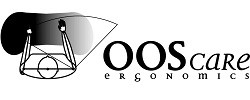Adjusting office seating
Traditionally there has been a distinction made between clerical chairs and management/executive chairs. The difference is becoming less valid as most if not all executives now use computers. The adjustments considered essential by ergonomists on a clerical office chair are:
- Height
- Backrest angle
- Lumbar support height
- Forward seat tilt - desirable.
Armrests on chairs are not generally recommended for people performing a large amount of keying/mousing as they generally restrict how far the chair can move in under the desk and may be too high for some users. However, armrests can help less mobile people push themselves out of the seat. If armrests are fitted to a chair then they should be height adjustable.
RELATIONSHIP BETWEEN SEAT, FLOOR AND DESK
The relationship between the three surfaces: work surface, seat pan, and floor, is important. To accommodate a range of people carrying out a variety of tasks, the seat pan, as well as one of the other two surfaces, must be adjustable in height. This means we need adjustable height work surfaces or footrests and furniture raisers. Adjustable height work surfaces are preferred.
Footrests act as a false floor. If the desk surface is fixed then it needs to be high enough for long lower legs (or furniture raisers used). The chair then needs to be able to be adjusted sufficiently high for a small person to sit with their arms appropriately positioned. Footrests will need to be provided for any person who cannot place their feet on the floor when the chair is adjusted for the task.
ADJUSTING THE FURNITURE
The work surface should be no higher than elbow height. For keying work, this often means the chair needs to be adjusted slightly higher, as the height of the middle row of keys is the effective work surface height. For writing tasks, people should lower their chair slightly to support their forearms.
When the work surface is height adjustable: sit on the chair and adjust its height until the user's feet are comfortably on the floor and there is no pressure under the thighs. Next move into the desk and adjust the work surface height until it is at elbow height when sitting in the correctly adjusted chair.
When the work surface is fixed: adjust the height of the chair to suit the work surface and if the user's feet are not flat on the floor without pressure points under the thighs, then add a footrest. If the work surface is too low for the user, you can add raisers under the desk legs to increase the height.
